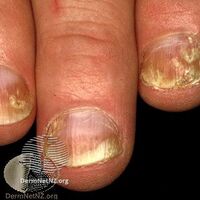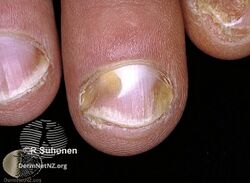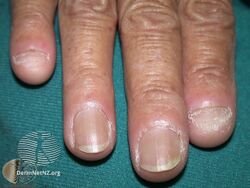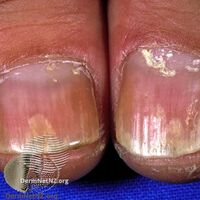Psoriatic onychodystrophy
| Psoriatic onychodystrophy | |
|---|---|
| Other names: Psoriatic nails | |
 | |
| Psoriasis of the toenails | |
| Specialty | Dermatology |
| Causes | Psoriasis |
| Differential diagnosis | Onychomycosis |
| Treatment | Medications, radiation |
| Frequency | 10% to 78% of those with psoriasis |
Psoriatic onychodystrophy or psoriatic nails is a nail disease in people with psoriasis.[1]: 781–2
The condition occurs in up to 80% of people with psoriasis.[2] The elderly and those with psoriatic arthritis are more likely to have psoriatic nails.[1]
Symptoms and signs
Psoriatic nails are characterized by a translucent discolouration in the nail bed that resembles a drop of oil beneath the nail plate.[3] Early signs that may accompany the "oil drop" include thickening of the lateral edges of the nail bed with or without resultant flattening or concavity of the nail; separation of the nail from the underlying nail bed, often in thin streaks from the tip-edge to the cuticle; sharp peaked "roof-ridge" raised lines from cuticle to tip; or separation of superficial layers of the nail followed by loss of patches of these superficial layers, leaving thin red nails beneath; or nail pitting–punctate changes along the nail plate surface.
-
Nail psoriasis
-
Nail psoriasis
-
Nail psoriasis
-
Nail psoriasis
Causes
The causes of nail psoriasis are unknown. It has been suggested that fungi may play a role.[4]
Diagnosis
The Nail Psoriasis Severity Index (NAPSI) is a numeric, reproducible, objective, simple tool for evaluation of nail psoriasis.[5] It evaluates several signs separately, each on a 1–3 scale: pitting, Beau's lines, subungual hyperkeratosis and onycholysis. A 2005 study proposed a modified NAPSI scale for persons with psoriasis and named the title of their publication "Modification of the Nail Psoriasis Severity Index".[6] Then, in 2007, a study found that there was a high level of inter-rater variability of the 2003 NAPSI scale and proposed another index which was, like the 2005 article, a modification of the 2003 article, and was named modified NAPSI.[7]
A 2008 study found that Cannavo's qualitative system[8] correlated with NAPSI (P<0.001) and is less time-consuming.[9] There is a risk of misdiagnosis with onychomycosis.
Treatment
There exist numerous treatments for nail psoriasis but there is little information concerning their effectiveness and safety.[10] Treatments include topical, intralesional, radiation, systemic, and combination therapies.
- Tacalcitol ointment[11] obtains a significant improvement in all nail parameters, both of the matrix and of the bed.
- Clobetasol nail lacquer and tacalcitol ointment[12]
- 5-fluorouracil. A reported side-effect is yellow nails[13]
- Calcipotriol[14]
- Calcipotriol plus betamethasone dipropionate ointment.[15]
- Efalizumab [16]
- Infliximab[17]
- Golimumab[18]
- Low dose methotrexate[19]
- Intralesional corticosteroid injection[20]
Relative effectiveness of treatments
Available studies lack sufficient power to extrapolate a standardized therapeutic regimen.[10]
As of April 2009, [needs update] an assessment of the evidence for the efficacy and safety of the treatments for nail psoriasis is in progress.[21]
- Infliximab appears to be the most effective treatment for nail psoriasis to date.[22]
- Results from low-dose acitretin therapy show NAPSI score reductions comparable with those studies evaluating biologic drugs for nail psoriasis and suggest that low-dose systemic acitretin should be considered in the treatment of nail psoriasis.[22]
A 2013 meta-analysis showed improvement of nail psoriasis with infliximab, golimumab, superficial radiotherapy, electron beam, and grenz rays compared to placebo.[23] Although systemic therapies have been shown to be beneficial, they may have serious adverse effects.[23] Topical treatments have not been well studied but may be beneficial.[23]
Research
Active clinical trials investigating nail psoriasis:[24]
Phase IV
- Effects of Etanercept.[25]
- Effects of Golimumab.[18]
Phase II
- Dose response and safety of topical Methotrexate.[26]
See also
References
- ↑ 1.0 1.1 James, William; Berger, Timothy; Elston, Dirk (2005). Andrews' Diseases of the Skin: Clinical Dermatology. (10th ed.). Saunders. ISBN 0-7216-2921-0.
- ↑ Berker, David de (2019). "20. Diseases of the nails". In Morris-Jones, Rachael (ed.). ABC of Dermatology (7th ed.). Hoboken: Wiley Blackwell. pp. 169–170. ISBN 978-1-119-48899-6. Archived from the original on 2023-07-01. Retrieved 2023-06-05.
- ↑ Kouskoukis, C.; Scher, R.; Ackerman, A. (1983). "The "oil drop" sign of psoriatic nails. A clinical finding specific for psoriasis". The American Journal of Dermatopathology. 5 (3): 259–262. doi:10.1097/00000372-198306000-00012. PMID 6625117.
- ↑ Szepietowski, C.; Salomon, J. (Nov 2007). "Do fungi play a role in psoriatic nails?". Mycoses. 50 (6): 437–442. doi:10.1111/j.1439-0507.2007.01405.x. ISSN 0933-7407. PMID 17944702. S2CID 37127086.
- ↑ Rich, P.; Scher, R. (2003). "Nail Psoriasis Severity Index: A useful tool for evaluation of nail psoriasis". Journal of the American Academy of Dermatology. 49 (2): 206–212. doi:10.1067/S0190-9622(03)00910-1. PMID 12894066.
- ↑ Parrish, CA; Sobera, JO; Elewski, BE (October 2005). "Modification of the Nail Psoriasis Severity Index". Journal of the American Academy of Dermatology. 53 (4): 745–6, author reply 746–7. doi:10.1016/j.jaad.2004.11.044. PMID 16198816.
- ↑ Cassell, S.; Bieber, J.; Rich, P.; Tutuncu, Z.; Lee, S.; Kalunian, K.; Wu, C.; Kavanaugh, A. (2007). "The modified Nail Psoriasis Severity Index: Validation of an instrument to assess psoriatic nail involvement in patients with psoriatic arthritis". The Journal of Rheumatology. 34 (1): 123–129. PMID 17216680.
- ↑ Cannavò, S. P.; Guarneri, F.; Vaccaro, M.; Borgia, F.; Guarneri, B. (2003). "Treatment of Psoriatic Nails with Topical Cyclosporin: A Prospective, Randomized Placebo-Controlled Study". Dermatology. 206 (2): 153–156. doi:10.1159/000068469. PMID 12592084. S2CID 20866096.
- ↑ Kaçar, N.; Ergin, Ş.; Erdo?an, B. (2007). "The comparison of Nail Psoriasis Severity Index with a less time-consuming qualitative system". Journal of the European Academy of Dermatology and Venereology. 22 (2): 219–22. doi:10.1111/j.1468-3083.2007.02389.x. PMID 18211416. S2CID 41847018.
- ↑ 10.0 10.1 Jiaravuthisan, M. M.; Sasseville, D.; Vender, R. B.; Murphy, F.; Muhn, C. Y. (2007). "Psoriasis of the nail: Anatomy, pathology, clinical presentation, and a review of the literature on therapy". Journal of the American Academy of Dermatology. 57 (1): 1–27. doi:10.1016/j.jaad.2005.07.073. PMID 17572277.
- ↑ Balbás, G. M.; Regaña, M. S.; Millet, P. U. (2009). "Tacalcitol ointment for the treatment of nail psoriasis". Journal of Dermatological Treatment. 20 (5): 308–310. doi:10.1080/09546630902787585. PMID 19367480.
- ↑ Snchez Regaa, M.; Mrquez Balbs, G.; Umbert Millet, P. (2008). "Nail psoriasis: A combined treatment with 8 clobetasol nail lacquer and tacalcitol ointment". Journal of the European Academy of Dermatology and Venereology. 22 (8): 963–969. doi:10.1111/j.1468-3083.2008.02679.x. PMID 18410337.
- ↑ Fiallo, P. (2009). "Yellow nails as an adverse reaction to the topical use of 5-fluorouracil for the treatment of nail psoriasis". Journal of Dermatological Treatment. 20 (5): 299–301. doi:10.1080/09546630902773494. PMID 19363737. S2CID 42262387.
- ↑ Tzung, T.; Chen, C.; Yang, C.; Lo, P.; Chen, Y. (2008). "Calcipotriol used as monotherapy or combination therapy with betamethasone dipropionate in the treatment of nail psoriasis". Acta Dermato-venereologica. 88 (3): 279–280. doi:10.2340/00015555-0401. PMID 18480933.
- ↑ Rigopoulos, D.; Gregoriou, S.; Daniel, III, C. R.; Belyayeva, H.; Larios, G.; Verra, P.; Stamou, C.; Kontochristopoulos, G.; Avgerinou, G.; Katsambas, A. (2009). "Treatment of Nail Psoriasis with a Two-Compound Formulation of Calcipotriol plus Betamethasone Dipropionate Ointment". Dermatology. 218 (4): 338–341. doi:10.1159/000202179. PMID 19212110. S2CID 36470967.
- ↑ Lamerson, C.; Stevens, G.; Sax, K. (2008). "Treatment of nail psoriasis with efalizumab: A preliminary study". Cutis; Cutaneous Medicine for the Practitioner. 82 (3): 217–220. PMID 18856162.
- ↑ Rigopoulos, D.; Gregoriou, S.; Stratigos, A.; Larios, G.; Korfitis, C.; Papaioannou, D.; Antoniou, C.; Ioannides, D. (2008). "Evaluation of the efficacy and safety of infliximab on psoriatic nails: An unblinded, nonrandomized, open-label study". British Journal of Dermatology. 159 (2): 453–456. doi:10.1111/j.1365-2133.2008.08686.x. PMID 18565184. S2CID 205257408.
- ↑ 18.0 18.1 Clinical trial number NCT00265096 for "A Study of the Safety and Efficacy of Golimumab in Patients With Active Psoriatic Arthritis (GO-REVEAL)" at ClinicalTrials.gov
- ↑ Lee, Julia Yu-Yun (November 2009). "Severe 20-nail psoriasis successfully treated by low dose methotrexate". Dermatology Online Journal. 15 (11): 8. PMID 19951644. Archived from the original on 2012-04-14. Retrieved 2013-05-20.
- ↑ Saleem, K.; Azim, W. (2008). "Treatment of nail psoriasis with a modified regimen of steroid injections". Journal of the College of Physicians and Surgeons--Pakistan : JCPSP. 18 (2): 78–81. PMID 18454890.
- ↑ Velema, Marieke; Hooft, Lotty; Lebwohl, Mark; Spuls, Phyllis I (2009). Spuls, Phyllis I (ed.). "Interventions for nail psoriasis". Protocols (1): CD007633. doi:10.1002/14651858.CD007633. hdl:2066/118676. PMID 23440816.
- ↑ 22.0 22.1 Noiles, K.; Vender, R. (2009). "Nail psoriasis and biologics". Journal of Cutaneous Medicine and Surgery. 13 (1): 1–5. doi:10.2310/7750.2008.08012. PMID 19298765. S2CID 26612674.
- ↑ 23.0 23.1 23.2 de Vries, Anna Christa Q; Bogaards, Nathalie A; Hooft, Lotty; Velema, Marieke; Pasch, Marcel; Lebwohl, Mark; Spuls, Phyllis I (2013-01-31). "Interventions for nail psoriasis". Cochrane Database of Systematic Reviews (1): CD007633. doi:10.1002/14651858.CD007633.pub2. hdl:2066/118676. ISSN 1465-1858. PMID 23440816. Archived from the original on 2018-06-18. Retrieved 2018-06-18.
- ↑ "clinicaltrials.gov". Archived from the original on 2015-05-03. Retrieved 2009-04-19.
- ↑ Clinical trial number NCT00581100 for "Effects of Etanercept on Nail Psoriasis and Plaque Psoriasis" at ClinicalTrials.gov
- ↑ Clinical trial number NCT00666354 for "Dose Response and Safety Study of Topical Methotrexate for the Treatment of Fingernail Psoriasis" at ClinicalTrials.gov
External links
| Classification |
|---|
- Nail psoriasis at Medscape Archived 2019-04-17 at the Wayback Machine



